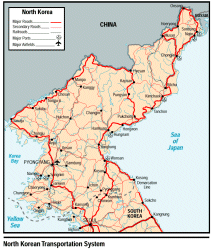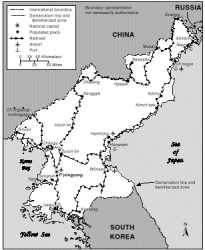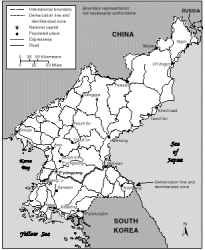





 An inadequate and outmoded infrastructure, particularly the transportation network, has severely impeded industrial growth, especially since the end of the disappointing Six-Year Plan. The magnitude of the problem was such that in 1977 Kim Il Sung identified the "transportation front" as the sector requiring the greatest effort that year. During the Second Seven-Year Plan, priority was assigned to modernizing and expanding the freightcarrying capacity in rail, road, and marine transport, as well as to centralizing and containerizing transport. The expansion and renovation of port facilities also received much investment in order to alleviate congestion and delay in the handling of cargo at ports. The same theme was basically repeated in the Third Seven-Year Plan.
An inadequate and outmoded infrastructure, particularly the transportation network, has severely impeded industrial growth, especially since the end of the disappointing Six-Year Plan. The magnitude of the problem was such that in 1977 Kim Il Sung identified the "transportation front" as the sector requiring the greatest effort that year. During the Second Seven-Year Plan, priority was assigned to modernizing and expanding the freightcarrying capacity in rail, road, and marine transport, as well as to centralizing and containerizing transport. The expansion and renovation of port facilities also received much investment in order to alleviate congestion and delay in the handling of cargo at ports. The same theme was basically repeated in the Third Seven-Year Plan.
 Railroads, the main means of transportation, had a total route length of 5,045 kilometers in 1990. In 1990 railroads hauled 90 percent of all freight, with 7 percent carried on roads and 3 percent of transport hauled by water. The comparative figures for passenger traffic were 62 percent, 37 percent, and 1 percent, respectively. By 1990 approximately 63 percent of the rail network was electrified, an important factor in improving traction capacity in mountainous terrain. The rail network itself is generally outdated and run-down and largely electricity dependent (90%), making the mobility of people and goods vulnerable to the electricity shortages frequently experienced throughout the country. Two major lines run north-south, one each along the east and west coasts. Two eastwest lines connect P'yongyang and Wonsan by a central and a southerly route, and a part of a third link line constructed in the 1980s connects provinces in the mountainous far north near the Chinese border. The railroad system is linked with those of China and Russia, although gauge inconsistencies necessitated some dual gauging with Russia. The Third Seven-Year Plan targeted an increase of 60 percent for railroad traffic through continued efforts in electrification, development of centralized and containerized transport, and modernization of transport management.
Railroads, the main means of transportation, had a total route length of 5,045 kilometers in 1990. In 1990 railroads hauled 90 percent of all freight, with 7 percent carried on roads and 3 percent of transport hauled by water. The comparative figures for passenger traffic were 62 percent, 37 percent, and 1 percent, respectively. By 1990 approximately 63 percent of the rail network was electrified, an important factor in improving traction capacity in mountainous terrain. The rail network itself is generally outdated and run-down and largely electricity dependent (90%), making the mobility of people and goods vulnerable to the electricity shortages frequently experienced throughout the country. Two major lines run north-south, one each along the east and west coasts. Two eastwest lines connect P'yongyang and Wonsan by a central and a southerly route, and a part of a third link line constructed in the 1980s connects provinces in the mountainous far north near the Chinese border. The railroad system is linked with those of China and Russia, although gauge inconsistencies necessitated some dual gauging with Russia. The Third Seven-Year Plan targeted an increase of 60 percent for railroad traffic through continued efforts in electrification, development of centralized and containerized transport, and modernization of transport management.
Frequent delays in service and a shortage of trains -- plus revolting conditions on the trains themselves -- have made rail travel difficult. First, there is the schedule problem. Anyone traveling by train must cope with frequent delays. Where it once required 5-6 hours to reach a certain destination, it now takes 2-3 days. One week is required for a typical train journey. As much as a month may be needed to travel from Yanggangdo to Pyongyang. Even when passengers can get aboard, travelling conditions are described as horrendous, because of frequent delays and gross overcrowding. "Standing room only" is often the rule, because space is so scarce and passengers are wedged together so tightly. The odor pervading the train under these conditions may be imagined. Incredibly by Western standards, servicemen changing their seats sometimes climb over the heads and shoulders of other passengers. Keenly aware that passengers must live on the train several days due to frequent delays in transit, food hawkers board the train carrying plenty of dried bread and cake, fried bread, cigarettes and glutinous rice jelly, and sell them at double the market price as soon as passengers' own provisions are exhausted.
 Apart from a few modern and rarely used motorways (there are no private cars and intercity buses and trucks are increasingly rare), DPRK infrastructure is characteristic of those of an underdeveloped country. Fuel constraints and the near absence of private automobiles have relegated road transportation to a secondary role. The road network was estimated between 23,000 and 30,000 kilometers in 1990, of which only 1,717 kilometers--7.5 percent--were paved; the rest were of dirt, crushed stone, or gravel, and poorly maintained. There are three major multilane highways: a 200-kilometer expressway connecting P'yongyang and Wnsan on the east coast, a forty-three-kilometer expressway connecting P'yongyang and its port, Namp'o, and a four-lane 100- kilometer highway linking P'yongyang and Kaesng. The overwhelming majority of the estimated 264,000 vehicles in use in 1990 were for the military. Rural bus service connects all villages, and cities have bus and tram services. In 1973 an extravagantly outfitted, two-line 30.5-kilometer subway system was completed in P'yongyang.
Water transport on the major rivers and along the coasts plays only a minor, but probably growing, role in freight and passenger traffic. Except for the Yalu and Taedong rivers, most of the inland waterways, totaling 2,253 kilometers, are navigable only by small craft. Coastal traffic is heaviest on the eastern seaboard, whose deeper waters can accommodate larger vessels. The major ports are Namp'o on the west coast and Najin, Ch'ngjin, Wnsan, and Hamh ng on the east coast. The country's harbor loading capacity in the 1990s was estimated at almost 35 million tons a year. In the early 1990s, North Korea possessed an oceangoing merchant fleet, largely domestically produced, of sixtyeight ships (of at least 1,000 gross-registered tons), totaling 465,801 gross-registered tons (709,442 deadweight tons), which includes fifty-eight cargo ships and two tankers. There is a continuing investment in upgrading and expanding port facilities, developing transportation--particularly on the Taedong River--and increasing the share of international cargo by domestic vessels.
Apart from a few modern and rarely used motorways (there are no private cars and intercity buses and trucks are increasingly rare), DPRK infrastructure is characteristic of those of an underdeveloped country. Fuel constraints and the near absence of private automobiles have relegated road transportation to a secondary role. The road network was estimated between 23,000 and 30,000 kilometers in 1990, of which only 1,717 kilometers--7.5 percent--were paved; the rest were of dirt, crushed stone, or gravel, and poorly maintained. There are three major multilane highways: a 200-kilometer expressway connecting P'yongyang and Wnsan on the east coast, a forty-three-kilometer expressway connecting P'yongyang and its port, Namp'o, and a four-lane 100- kilometer highway linking P'yongyang and Kaesng. The overwhelming majority of the estimated 264,000 vehicles in use in 1990 were for the military. Rural bus service connects all villages, and cities have bus and tram services. In 1973 an extravagantly outfitted, two-line 30.5-kilometer subway system was completed in P'yongyang.
Water transport on the major rivers and along the coasts plays only a minor, but probably growing, role in freight and passenger traffic. Except for the Yalu and Taedong rivers, most of the inland waterways, totaling 2,253 kilometers, are navigable only by small craft. Coastal traffic is heaviest on the eastern seaboard, whose deeper waters can accommodate larger vessels. The major ports are Namp'o on the west coast and Najin, Ch'ngjin, Wnsan, and Hamh ng on the east coast. The country's harbor loading capacity in the 1990s was estimated at almost 35 million tons a year. In the early 1990s, North Korea possessed an oceangoing merchant fleet, largely domestically produced, of sixtyeight ships (of at least 1,000 gross-registered tons), totaling 465,801 gross-registered tons (709,442 deadweight tons), which includes fifty-eight cargo ships and two tankers. There is a continuing investment in upgrading and expanding port facilities, developing transportation--particularly on the Taedong River--and increasing the share of international cargo by domestic vessels.
